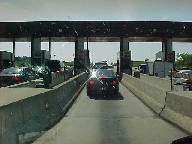Background Information

Waiting in line for toll booths is starting
to become a thing of the past as variable tolling begins to emerge and better technology is developed.


Variable tolling refers to charging a vehicle different toll rates based on the time of day or level of congestion of a roadway.
Linear Road is inspired by the increasing prevalence of variable tolling on highway systems in cities throughout the world. Linear Road specifies a variable tolling system for a fictional urban expressway system where tolls are determined based on changing factors such as congestion and accident proximity. Each car on the expressway is equipped with a transponder or sensor that emits a position report that identifies the vehicle’s exact location (coordinates) every 30 seconds. These position reports are used to generate statistics about traffic conditions on every segment of every expressway for every minute. These statistics, including average vehicle speed, number of vehicles and existence of accidents, are used to determine toll charges for the given segment of road that the vehicle is in. This tolling is designed to control the traffic flow roadways by discouraging drivers from using already congested roads through increased tolls. Alternatively, this may encourage the use of less congested roads through decreased tolls.